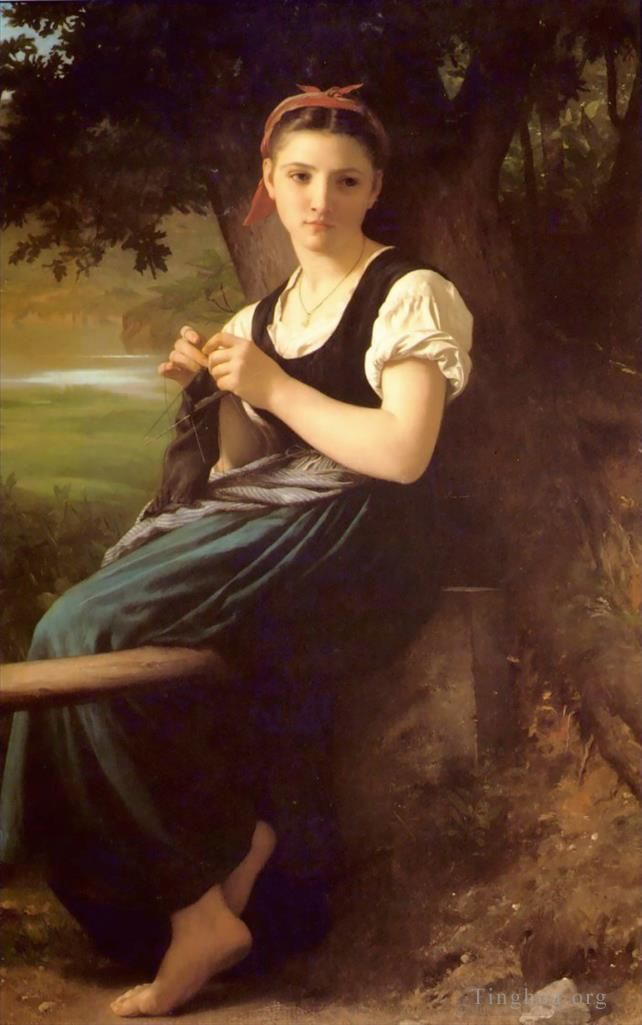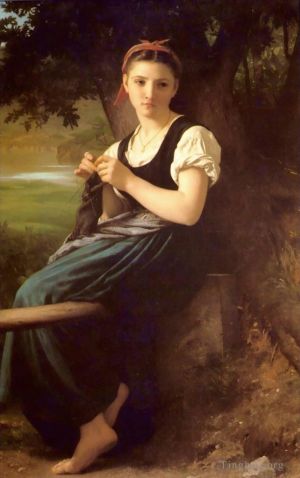The Knitting Girl
William-Adolphe Bouguereau
- Price: Price on Request
- Art Type: Oil Painting
- Size:
- English Comments: 0
- International Comments: 0
- Creating Date:
- Introduction and Works of William-Adolphe Bouguereau >>
Work Overview
- The Knitting Girl
French: La Couseuse
The Knitting Girl (1856)
Artist William-Adolphe Bouguereau
Year 1869
Medium Oil on canvas
Dimensions 145 cm × 99 cm (57 in × 39 in)
Location Joslyn Art Museum, Omaha
The Knitting Girl (French: La Couseuse) is a painting created by nineteenth century French artist William-Adolphe Bouguereau in 1869. The painting is also referred to as Knitting Anne due to the simplistic nature of the young woman portrayed in the painting. The painting is currently held in the Joslyn Art Museum in Omaha, Nebraska in the United States.
In the mid-1860s, William Adolphe Bouguereau began painting idealized images of peasant women and children. Joslyn’s The Knitting Girl is Bouguereau’s first and most monumental representation of the image. Sitting serenely under a tree, this young girl is lost in thought as she knits. Dressed in simple clothes for the day (and barefoot!), she’s a wonderful example of the beauty of the everyday in art.
Bouguereau, an Academic painter par excellence, developed two main themes: sentimentalized images of pretty peasant, gypsy, and beggar girls and idealized female nudes personifying abstract concepts such as the seasons. Like Academic painters in general, Bouguereau’s artistic reputation has varied greatly. Celebrated in the nineteenth century, he was discredited in the twentieth for clinging to an outmoded tradition, only to be appreciated again recently for his superb technical mastery.
The painting is also fondly known within the art world asKnitting Annebecause of the natural and simplistic manner in which the painting captures the young woman.
Today, The Knitting Girl, can be found in Nebraska at the Joslyn Art Museum.The oil on canvas painting measures 57 inches by 39 inches.
It was during the middle of the 1860s that Bouguereau began to paint images of peasant girls and women in an idealised manner. The Knitting Girl is one such painting, and the first one in this genre.
Today this painting is by far the most influential representation of this group within society during the middle 1800s.
What we observe when we view The Knitting Girl, is a young girl sat on the ground, her back against a large tree trunk. She appears peaceful and to be enjoying the quiet contemplation of knitting in the fresh air.
She is wearing peasants clothing, of a simple style, and is barefoot. There is nothing extraordinary in her outward appearance, but Bouguereau has managed to paint her radiant beauty in such a simplistic and exquisite way.
What this painting evokes is that the everyday can indeed be beautiful.
Bouguereau was an academic scholar as well as a realist painter. He predominantly painted in two genres. He painted his idealised versions of everyday women, as shown in this painting, as well as the personification of goddesses taken from Greek literature and myths.
His peasant paintings idealised the female form, the female body, and he did so with the use of subtle hues and gentle lighting on the canvas. The Knitting Girl consists of soft browns, greys and greens. The only colour stems from the girl's face and her bare feet. Therefore, as an observers are drawn to her pretty face, sculpted mouth and twinkling eyes.
As Bouguereau was viewed as an academic painter, his art came under much scrutiny. Surprisingly, it was during the twentieth century that his art was criticised for using antiquated and outdated methods, whereas during the twenty-first century, his work was once again celebrated.
- Copyright Statement:
All the reproduction of any forms about this work unauthorized by Singing Palette including images, texts and so on will be deemed to be violating the Copyright Laws.
To cite this webpage, please link back here.
- >> English Comments
- >> Chinese Comments
- >> French Comments
- >> German Comments
- >>Report
- Litalienne au tambourin
- Compassion
- Far Niente
- The Return of Spring
- The chilly
- Cupid and Psyche
- Jeune fille allant a la fontaine
- FemmeAuCoquillage 1885
- Jeune italienne puisant de leau
- The Madonna of the Lilies
- The Dance
- Le Baiser 1863
- The Shepherdess
- Reverie
- Girl with bouquet
- Homere et son guide
- The Prisoner
- After the Bath
- Le repos
- Tricoteuse 1879
- Charity
- Jeune ouvriere
- LAmour et Psyche enfants
- Parure des champs
- The Broken Pitcher
- Lady with Glove 1870
- Seated Nude
- Femme Blonde profil 1898
- La tricoteuse
- Adolphe Juene Fille Et Enfant MiCorps
- Portrait de lartiste
- Lidylle
- A Portrait of Leonie
- Idylle 1851
- Etude dune femme pour Offrande a lAmour
- Jeunes bohemiennes
- Le secret
- Le Jeune Bergere 1897
- Soul Carried to Heaven
- Sur la greve
- Temptation 1880
- Maternal Admiration
- The First Mourning
- Le jeune frere 1900
- Unfinished detail
- Sainte Famille
- NotreDame Des Anges
- The Nut Gatherers
- After the Bath
- Madame la Comtesse de Cambaceres
- Madone assise
- Evening Mood (Twilight or Dusk)
- Gabrielle Cot 1890
- Portrait of a Young Girl
- The Birth of Venus
- Cupid with Butterfly
- Work Interrupted
- Une Vocation
- Bohemienne au Tambour de Basque
- Jeune Fille et Enfant
- Etude tete de petite fille tete de petite fille
- Loin du pays
- La Vierge LEnfant Jesus et Saint Jean Baptiste2
- The Mischievous One
- Inspiration
- Le Lever
- Fileuse
- Faneuse
- Washerwomen of Fouesnant 1869
- Paquerettes
- Les Oreades 1902
- Psyche
- Young Woman Contemplating Two Embracing Children
- Boucles DOreilles The earrings 1891
- The Return from the Harvest
- Etude Femme Blondede face 1898
- Study for Vierge aux anges
- TheBather 1879
- Jeunesse Realism angel
- The Virgin with Angels (The Queen of the angels)
- La grappe de raisin
- Marguerite
- La brie du printemps
- La Soupe
- Berceuse
- Brother and Sister
- Au bord du ruisseau
- Psyche et LAmour
- The Nymphaeum
- Vierge consolatrice
- Baigneuse 1870
- Une vocation 1896
- The Youth of Bacchus
- Petite bergere
- A Portrait of Eugene
- Lart et la litterature
- Le Passage du gue
- Un moment repos
- The Heart’s Awakening
- La Charite 1859
- The Madonna of the Roses
- The Young Shepherdess
- Calinerie
- The Storm
- La bourrique oil on canvas
- Branche de laurier
- Le jour (Day)
- La reverence
- Mailice
- Lady Maxwell 1890
- Little beggars
- Avant le bain
- Jeune bergere 1868
- La vague
- Adolphe MAUVAISE ECOLIERE
- La priere
- Le gouter
- Pieta 1876
- Will8iam Dante et Virgile au Enfers
- The Goose Girl 1891
- Linnocence
- La Vierge LEnfant Jesus et Saint Jean Baptiste
- Beaute Romane 1904
- Loves Resistance 1885
- Moissoneuse
- The Motherland (Alma Parens)
- Reve de printemps
- A Portrait of Amelina Dufaud
- Unknown
- The Bohemian
- Portrait of a young girl 1896
- Irene
- Meditation
- The Assault
- Priestess
- La soeur ainee
- Day 1881
- The Shell
- La Vierge a Lagneau
- Bergere
- Orestes Pursued by the Furies
- Tobias Saying Goodbye to his Father 1860
- La lecon difficile
- Douleur damour
- Frere et Soeur
- Le jeune frere
- Bergere 1886
- Laurore
- Le retour du marche
- Petite boudeuse
- Song of the Angels (Virgin of the Angels)
- En penitence
- Le Crab
- La Petite Mendiante
- La soif
- The Shepherdess 1873
- The Invasion
- Petites maraudeuses
- Girl Holding Lemons 1899
- Zenobia Found by Shepherds
- Portrait Of Genevieve Celine Eldest Dau
- Flight of Love
- La Charite Romaine
- Portrait de Mlle Brissac
- Les pommes
- La palme
- Nymphs and Satyr
- Reflexion
- Flagellation of Our Lord Jesus Christ
- Wet Cupid
- The Abduction of Psyche
- The Bathers (The Two Bathers)
- Le jour des morts
- Ladmiration
- Les Jeunes Baigneuses
- Child Braiding A Crown
- Slumber
- The Little Marauder 1900
- The Pastoral Recreation 1868
- Mignon Pensive
- Unknown1
- The Knitting Girl
- Yvonne
- Meditation 1885
- Frere et soeur bretons
- Unfinished
- Biblis
- Portrait Of Madame Olry Roederer
- A Childhood Idyll
- La Gue
- Fardeau agreable
- La jeunesse de Bacchus centre dt
- The Thank Offering
- Jeune fille se defendant contre lamour
- Etude Tete de Jeune fille
- Retour des champs
- Lost Pleiad
- Les prunes
- Portrait de Mademoiselle Elizabeth Gardner
- Amour a laffut angel
- Harvester (The Grape Picker)
- La Comtesse de Montholon
- A la fontaine
- Portrait of a Young Girl Crocheting
- A Portrait of Genevieve
- La couturiere
- Femme de Cervara et Son Enfant 1861
- Modestie
- Deux soeurs
- Drawing of a Woman
- Night
- Mars
- Laurore Realism WilliamAdolphe
- Flagellation of Christ study in pencil
- Study of a Seated Veiled Female Figure









 Singing Palette
Singing Palette